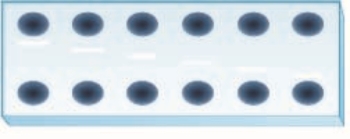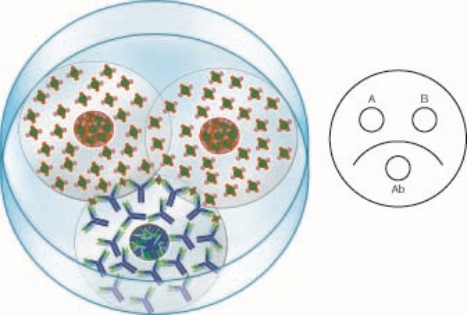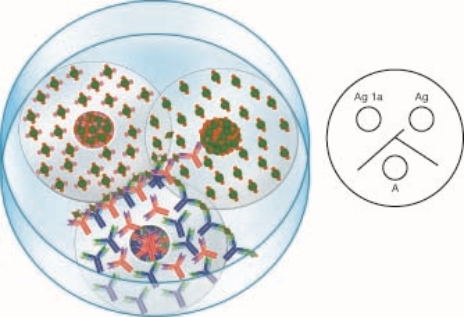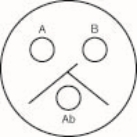A) more, usually
B) equally, never
C) more, always
D) less, usually
F) All of the above
Correct Answer

verified
A
Correct Answer
verified
Multiple Choice
Regarding the affinity of antibody to antigen,
A) Ka = [Ab][Ag]/[AbAg]
B) Ka = [AbAg]/[Ab][Ag]
C) Kd = [Ab][Ag]/[AgAb]
D) none of the above
F) B) and C)
Correct Answer

verified
Correct Answer
verified
Multiple Choice
 If the antibody's concentration is the same in all the wells at the bottom of the double diffusion gel precipitation reaction in the figure
If the antibody's concentration is the same in all the wells at the bottom of the double diffusion gel precipitation reaction in the figure
A) and the antigen is the same in each well, the concentration of the antigen in the wells is higher on the right side of the gel than on the left side
B) and the antigen is the same in each well, the antigen's concentration in the wells is higher on the left side of the gel
C) there is not enough information to choose one answer
D) the reactions on the left side of the gel are in prozone; the reactions on the right side of the gel are in postzone.
F) A) and D)
Correct Answer

verified
Correct Answer
verified
Multiple Choice
A) The graph in the figure shows the results of an endpoint incubation of an RID using the Mancini method to plot density squared (d2) versus concentration
B) The graph in the figure shows the results of an endpoint incubation of an RID using the Fahey method to plot d2 versus concentration
C) The graph in the figure shows the results of an endpoint incubation of an RID using the Mancini method to plot diameter squared versus concentration.
D) The graph shows none of the above.
F) A) and C)
Correct Answer

verified
Correct Answer
verified
Multiple Choice
 The antigen in well A is
The antigen in well A is
A) the same as the antigen in well B
B) not at all like the antigen in well B
C) partially the same as the antigen in well B
D) the same as the antigen in well B but has an extra antigen in the well
F) B) and C)
Correct Answer

verified
Correct Answer
verified
Multiple Choice
Agglutination is
A) less sensitive than precipitation
B) more sensitive than precipitation if the particles are highly charged
C) better with IgM at lower temperatures (4-27°)
D) called passive agglutination when the antigen is naturally part of the particle
F) A) and C)
Correct Answer

verified
Correct Answer
verified
Multiple Choice
Equivalence occurs when the
A) antibody-binding sites approximately equal the antigen-binding sites, and the largest complexes form
B) antibody-binding sites approximately equal twice the antigen-binding sites, and the largest complexes form
C) postzone has been passed, more antigen has been added, and the largest complexes form
D) prozone has been passed, more antibody has been added, and the largest complexes form
E) A and C.
G) C) and E)
Correct Answer

verified
Correct Answer
verified
Multiple Choice
To determine whether a patient has autoimmune hemolytic anemia, we can add anti-human immunoglobulin to the person's red blood cells, which is
A) a reverse passive test
B) a competitive assay
C) an indirect antiglobulin test
D) a direct antiglobulin test
F) B) and C)
Correct Answer

verified
Correct Answer
verified
Multiple Choice
In PETINA,
A) the residual nonagglutinating particles are counted
B) the drug in the patient's serum increases turbidity
C) the drug in the patient's serum decreases turbidity
D) the drug in the patients serum decreases the number of residual nonagglutinating particles
F) B) and C)
Correct Answer

verified
Correct Answer
verified
Multiple Choice
Radial immunodiffusion can be used to measure
A) IgM, IgG, and IgA
B) some complement components
C) IgM, IgG, IgA, and IgE
D) A and B.
E) B and C
G) All of the above
Correct Answer

verified
Correct Answer
verified
Multiple Choice
A quantitative procedure
A) Ouchterlony
B) double diffusion gel precipitation reaction
C) single diffusion gel precipitation
D) radial immunodiffusion
E) C and D
G) A) and C)
Correct Answer

verified
Correct Answer
verified
Multiple Choice
When we ran the serum of a patient who seems to be severely ill with arthritis at the lowest dilution suggested by the latex agglutination kit, the results were negative. What should we do?
A) Report the results to the physician and suggest the patient return in two weeks when his titer might be higher.
B) Report the results to the physician and suggest testing for Lyme disease.
C) Dilute the sample and run it again before the results are reported.
D) Use a different company's kit.
F) C) and D)
Correct Answer

verified
C
Correct Answer
verified
Multiple Choice
The zeta potential is the
A) charge on the particles that will be aggregated
B) effect of the treatment of an antibody molecule with electrophoresis
C) potential that an antibody will aggregate the particles
D) potential that the reaction will occur in the postzone
F) C) and D)
Correct Answer

verified
A
Correct Answer
verified
Multiple Choice
 The spur in the preceding reaction contains
The spur in the preceding reaction contains
A) anti-1 and 1
B) anti-2 and 2
C) anti-a and a
D) all of the above
F) A) and D)
Correct Answer

verified
Correct Answer
verified
Multiple Choice
When a mom and a dad have the same ABO blood group but different RH blood typesand- mom is RH negative and dad RH is positiveto determine if mom has made anti-D-
A) mom can be checked with the indirect agglutination test
B) mom and the baby can be checked with the direct agglutination test
C) mom can be checked with the indirect agglutination test, and baby can be tested with the direct agglutination test
D) mom can be checked with the direct agglutination test, and baby can be checked with the indirect agglutination test
F) A) and B)
Correct Answer

verified
Correct Answer
verified
Multiple Choice
To increase agglutination, we could
A) decrease viscosity of the media
B) increase the waters of hydration
C) add low ionic strength media
D) bring the temperature up to 56° for optimum antibody binding
F) A) and C)
Correct Answer

verified
Correct Answer
verified
Multiple Choice
 In the Ouchterlony in the figure,
In the Ouchterlony in the figure,
A) A and B have a molecule that shares an epitope, but the molecule from A has an extra epitope
B) A and B have a molecule that shares an epitope, but the molecule from B has an extra epitope
C) A and B do not have a molecule that shares an epitope, and the molecule from A has is a faster diffusion coefficient
D) A and B do not have a molecule that shares an epitope, and the molecule from B has is higher molecular weight
F) All of the above
Correct Answer

verified
Correct Answer
verified
Multiple Choice
To measure the amount of rheumatoid factor in a patient's serum, we perform
A) a passive latex agglutination with Fc regions on the particle
B) an inhibition of a passive latex agglutination reaction
C) reverse passive latex agglutination with Fc regions on the beads sticking out
D) reverse passive latex agglutination with Fc regions added in solution
F) A) and C)
Correct Answer

verified
Correct Answer
verified
Multiple Choice
Nephelometry and turbidimetry differ because
A) although both measure the effect of aggregates on light passing through a solution, turbidimetry measures the light scattered at 10-90°, and nephelometry measures the light that goes directly through the solution
B) although both measure the effect of aggregates on light passing through a solution, turbidimetry measures the light scattered at 10-90°, and nephelometry measures the light that is polarized
C) nephelometry uses instrumentation but turbidimetry does not
D) although both measure the effect of aggregates on light passing through a solution, nephelometry measures the light scattered at 10-90°, and turbidimetry measures the light that goes directly through the solution
F) All of the above
Correct Answer

verified
Correct Answer
verified
Multiple Choice
Nephelometry
A) is less sensitive than turbidimetry and is measured directly across from the beam of light that has gone through the sample
B) is more sensitive than turbidimetry and is measured directly across from the beam of light that has gone through the sample
C) is more sensitive than turbidimetry and is measured at a 10-90° angle from the beam of light that has gone through the sample
D) is less sensitive than turbidimetry and is measured at a 10-90° angle from the beam of light that has gone through the sample
F) None of the above
Correct Answer

verified
Correct Answer
verified
Showing 1 - 20 of 32
Related Exams